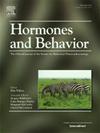Hormonal contraceptive use in relation to basal and reactive testosterone, DHEAS, and cortisol
IF 2.4
3区 医学
Q2 BEHAVIORAL SCIENCES
引用次数: 0
Abstract
A burgeoning area of research has begun to uncover a wide range of potential neurological and psychological correlates of hormonal contraceptive (HC) use. Yet there remains a limited understanding of the underlying mechanisms for how HC use alters aspects of neurobiology and related behavioral outcomes. Uncovering these processes has the potential for new discovery in the field of behavioral neuroendocrinology, particularly in the complex interplay between steroid hormone subclasses. Although prior research has often focused on the effects of HC use on progestogen and estrogen disruption, basal and reactive androgens and cortisol may also be significantly impacted by HC use and serve critical functions throughout the brain and body. We discuss important background information on the synthesis and function of three steroid hormones – testosterone, dehydroepiandrosterone-sulfate (DHEAS), and cortisol, review prior research showing how HC use is related to circulating (basal) and reactive levels, and provide sample data on salivary levels from our own research. The combined evidence shows that HC use, specifically of the OC pill, is associated with significantly reduced total, free, and salivary androgens, increased total cortisol in blood but not saliva, and a blunted salivary cortisol response to social stressors. Limited evidence provides initial indication that the specific estrogen and progestin compounds in HC formulas may differentially impact steroid hormone levels. Finally, we discuss the mechanisms by which HCs alter steroid hormone levels, the potential implications of these effects on brain and behavior outcomes, and considerations for future research.
激素避孕药的使用与基础和反应性睾酮,DHEAS和皮质醇的关系
一个新兴的研究领域已经开始揭示激素避孕药(HC)使用的广泛潜在的神经和心理相关。然而,对于HC的使用如何改变神经生物学和相关行为结果的潜在机制,人们的理解仍然有限。揭示这些过程有可能在行为神经内分泌学领域,特别是在类固醇激素亚类之间复杂的相互作用方面有新的发现。虽然先前的研究通常集中在HC使用对孕激素和雌激素破坏的影响上,但基础和反应性雄激素和皮质醇也可能受到HC使用的显著影响,并在整个大脑和身体中发挥关键作用。我们讨论了三种类固醇激素——睾酮、硫酸脱氢表雄酮(DHEAS)和皮质醇的合成和功能的重要背景信息,回顾了先前的研究,表明HC的使用如何与循环(基础)和反应水平相关,并提供了我们自己研究的唾液水平样本数据。综合证据表明,使用HC,特别是使用OC药丸,与总雄激素、游离雄激素和唾液雄激素显著降低、血液中总皮质醇增加而不是唾液中总皮质醇增加以及对社会压力源的唾液皮质醇反应减弱有关。有限的证据初步表明,HC配方中特定的雌激素和黄体酮化合物可能会对类固醇激素水平产生不同的影响。最后,我们讨论了hc改变类固醇激素水平的机制,这些影响对大脑和行为结果的潜在影响,以及对未来研究的考虑。
本文章由计算机程序翻译,如有差异,请以英文原文为准。
求助全文
约1分钟内获得全文
求助全文
来源期刊

Hormones and Behavior
医学-行为科学
CiteScore
6.70
自引率
8.60%
发文量
139
审稿时长
91 days
期刊介绍:
Hormones and Behavior publishes original research articles, reviews and special issues concerning hormone-brain-behavior relationships, broadly defined. The journal''s scope ranges from laboratory and field studies concerning neuroendocrine as well as endocrine mechanisms controlling the development or adult expression of behavior to studies concerning the environmental control and evolutionary significance of hormone-behavior relationships. The journal welcomes studies conducted on species ranging from invertebrates to mammals, including humans.
 求助内容:
求助内容: 应助结果提醒方式:
应助结果提醒方式:


